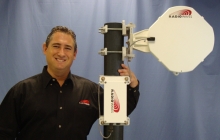London to get high-accuracy technology by 2012?
Governments are increasingly requiring mobile operators to install high accuracy location technology and intelligence to enable authorities to track users and protect borders and specific facilities, according to one technology provider.
Brian Varano, CMO of TruePosition, a location technology company, told Mobile Europe that Government agencies are increasingly asking mobile operators to install advanced location technology, allied to network intelligence software, to combat crime and terrorism.
Using a variety of location techniques and software operators can trace call locations to high accuracies, but also track call networks, when SIMs are swapped, when non-authorised users enter certain areas, and so on.
Publicly, the location companies speak of 50m location accuracies, but the truth is that they can be a lot more accurate even than that. “We tend to stick to talking about 50m in public,” Varano, said. TruePosition markets a solution based on U-TDOA (Uplink Time Difference of Arrival) that measures the time taken for signals to arrive from a phone to cell sites. It requires receivers in the base stations in the areas the operator requires coverage, and can provide highly accurate location information even in urban or tough indoor environments.
All of TruePosition’s $200 million revenues now come directly from the Government sector, head of marketing Brian Varano said, but the company still needs to reach out to the telco sector itself to “sweeten the deal” for the installation of the equipment and technology. Varano said that the company is in discussion with “certain agencies” about deploying such advanced systems in time for the London 2012 Olympics.
“Operators need to know this isn’t going to have any adverse impact on their networks, or affect users in any other way,” he said. Where a commercial discussion is necessary, they can also be made aware that there may be commercial opportunities for them in having such high accuracy location technologies available.
Which emergency service do you require, and are you a premium user?
Varano said that the operator could sell accurate location as a premium emergency service – for instance customers willing to spend a couple of dollars a month would know that in the event of their calling 911/112 they would be located as accurately as possible.
Or the operator could sell back to Government agencies information about users – either on a per-use or subscription basis. Another application could be to provide high accuracy location information for vulnerable users, such as those with dementia or autism, Varano said. This could defray or justify the cost of investment in the equipment.
Of course, in some countries no such sweeteners are required – the Government gets what the Government wants. But in other territories TruePosition wants to make operators aware that installing the technology need not just be an imposition but could also be a revenue generator for them.



